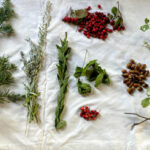
Making your own natural cough lozenges can be a rewarding way to address sore throats and coughs with the ingredients you choose. Herbal lozenges, sometimes called pastilles or cough drops, are small, solid preparations designed to be dissolved in the mouth, providing soothing relief to irritated throat tissues and delivering healing herbal properties. They can also be a pleasant way to take herbs, especially for children.
There are a few different approaches to making herbal lozenges, ranging from hard candy-like drops to softer melts or pastes.
I’ve created an in-depth guide covering some of the most popular methods used to make natural cough lozenges at home.
If you have never made your own cough drops, now is the time to experiment! They’re easier to make than you think 🙂
How to Make Natural Cough Lozenges
Method 1: Hard Candy Lozenges
This method involves creating a hard candy base from a concentrated herbal decoction and a sweetener (I like using honey), then allowing it to harden into lozenge-sized pieces.
It requires careful temperature control, similar to making traditional hard candy, but the results are worth the effort!
What you’ll need:
- A strong herbal decoction (a concentrated liquid extraction). You can learn how to make an herbal decoction HERE.
- Sweetener: Granulated sugar or honey. Honey can be particularly soothing and is what I prefer to use.
- Optional: Cream of tartar (especially if using honey, helps with hardening), Essential oils (like peppermint or orange) for flavor and added benefits, other flavorings like lemon juice.
- Equipment: Saucepan (preferably heavy-bottomed), Candy thermometer, Candy molds or a heat-safe surface lined with parchment paper.
Preparation:
- Make a Strong Herbal Decoction: Choose herbs suitable for coughs and sore throats (see “Selecting Herbs” below). Combine dried herbs (e.g., horehound, wild cherry, mullein, licorice, ginger, thyme, aniseeds) with water in a saucepan. Bring to a boil, then reduce heat and simmer, uncovered, until the liquid is reduced by half. This concentrates the herbal properties. Strain the liquid thoroughly through a fine mesh strainer to remove all herb particles.
- Combine with Sweetener: Measure a specific amount of the strained herbal liquid (e.g., 1 cup) and add it to a clean saucepan with your chosen sweetener(s). If using sugar, you might use a ratio like 2 cups organic raw sugar per 1 cup decoction. If using honey, a ratio like 1 to 1 can work, or slightly less honey. You can also combine sweeteners.
- Heat to Hard-Crack Stage: Stir the mixture over low to medium-high heat to dissolve the sugar or honey completely. Once dissolved, stir only occasionally to prevent crystallization, avoiding scraping the sides of the pan. Heat the mixture until it reaches the hard-crack stage, which is typically between 290°F and 310°F on a candy thermometer. You can test this by dropping a small amount into ice water; it should harden immediately and be brittle. Use caution as boiled sugar is extremely hot.
- Add Flavorings (Optional): If adding essential oils, remove the mixture from the heat and let it cool slightly before stirring them in. This prevents the heat from degrading the oils.
- Pour into Molds: Carefully pour the hot syrup into candy molds or onto a prepared surface.
- Cool and Harden: Allow the lozenges to cool completely and harden. Once set, they can be removed from molds or broken into pieces (if poured onto a sheet).
- Store: Store the hardened lozenges in an airtight container in a cool, dark place. Homemade hard candy can soften over time, so it’s best used within a month.
- To Prevent Lozenges From Sticking: Wrap them individually after they have cooled completely in waxed paper. Alternatively, after they cool, you can dust them with a powder, such as slippery elm bark powder, which can help prevent sticking. Another option is to drop the hot candy mixture into powdered sugar to form drops and then roll them in the sugar to coat them when they cool. Using cream of tartar, especially when using honey, can help offset excess moisture and aid in the hardening process, which helps reduce the tendency to soften and stick.
Method 2: Mucilage/Paste Lozenges (Pastilles)
This method involves combining finely powdered herbs with a mucilaginous binder and a sweetener to form a mass that is then shaped.
This avoids the high heat of the hard candy method and is a very user-friendly way to make homemade cough lozenges.
What you’ll need:
- Finely powdered herbs like elderberries, horehound, yarrow flowers, sage leaf, wild cherry bark, and licorice root.
- A mucilage source/binder: Powders like slippery elm bark or marshmallow root are common, as are gums like gum arabic or gum tragacanth.
- Sweetener/Binder: Honey or glycerine. Honey is often used to make powdered herbs palatable.
- Optional: Warm water or a strong herbal infusion to help bind other flavorings like spices (ginger, cloves, cinnamon), or essential oils.
- Equipment: Mortar and pestle or coffee grinder for powdering herbs, Bowls for mixing, Tools for shaping (e.g., rolling pin, knife, small molds, ice cube tray, etc.).
Preparation:
- Powder Herbs: Ensure your chosen herbs are very finely powdered. A mortar and pestle or a dedicated grinder like this one can help achieve the desired fineness (#60 & #80 powder is best).
- Combine Dry Ingredients: In a bowl, mix the finely powdered herbs and your mucilage powder (like slippery elm or marshmallow root).
- Add Sweetener/Binder: Gradually add honey, glycerine, or a mixture of sweetener and a small amount of warm water or herbal infusion. Mix until a workable mass is formed. The goal is a paste that is slightly sticky but can be handled and shaped. This stage might require trial and error to get the right consistency.
- Add Flavorings (Optional): Mix in spices or essential oils.
- Shape Lozenges: Roll the mass flat and cut it into squares or shapes, or roll it into small balls. For a softer, meltable lozenge, you can press the mixture into a mold, such as a small ice cube tray.
- Set/Dry: If making traditional pastilles, allow them to air dry until firm. If making soft melts, place the mold in the refrigerator or freezer to set.
- Store: Store dry pastilles in an airtight container in a cool, dark place. Store soft melts in the refrigerator. Shelf life for this method can vary; soft melts are best used within a month.
Method 3: Soft Melt Variation (from Method 2)
This is a simpler variation resulting in a softer, meltable consistency. These are great for younger kids who have trouble sucking on traditional lozenges.
What you’ll need:
Steps (Ginger & Honey Throat Melts):
- In a bowl, stir together 3 tablespoons coconut oil, 1 teaspoon marshmallow root or slippery elm powder, 1 teaspoon honey, ¼ teaspoon ground ginger, and ¼ teaspoon ground cloves.
- Mix until well combined.
- Pour the mixture into an ice cube tray. This recipe makes about 8-10 melts.
- Place in the freezer to set.
- Once set, store in an airtight container in the refrigerator. Suck on one as needed for relief.
Selecting Herbs for Lozenges:
The best herbs depend on the type of cough or throat irritation.
- For Sore, Irritated Throats: Demulcent herbs like licorice root (also anti-inflammatory, soothing), marshmallow root, and slippery elm bark are excellent for coating and soothing membranes. Ginger is good for easing pain and inflammation. Chamomile is also soothing.
- For Dry, Hacking Coughs: Antitussive herbs help mitigate cough. Wild cherry bark is indicated if tracheitis is present or for spasmodic coughs. Mullein is useful for dry, hacking, unproductive coughs and whooping cough. Licorice is also an antitussive. Moistening herbs like marshmallow and slippery elm help moisten the lungs.
- For Productive, Congested Coughs: Expectorant herbs help loosen phlegm and make coughs more productive. Elecampane and fennel help clear airways. Thyme acts as an expectorant. Mullein is anticatarrhal. Horehound is a useful expectorant for cough syrups.
- For Bronchitis: Thyme is an effective antiseptic. Garlic can help fight bronchitis.
- For Spasmodic Coughs: Antitussives like thyme, lobelia, wild cherry bark, mullein, and grindelia can help.
- For Immune Support: Herbs like echinacea, elderberry, and garlic can be beneficial, especially during cold and flu season.
Many recipes combine several herbs to provide multiple actions, such as soothing, expectorant, and antitussive properties. Licorice is frequently included not just for its medicinal properties but also to add a pleasant taste and help harmonize the blend.
Practical Tips and Considerations:
- Palatability: Sweeteners like honey and sugar make medicinal lozenges more palatable. Adding spices or essential oils can further improve taste and add therapeutic benefits.
- Usage: Suck on a lozenge as needed to ease soothe the throat and calm the spasms associated with cough.
- Storage: Generally, store lozenges in an airtight container in a cool, dark place. Soft melts should be refrigerated.
- Shelf Life: Homemade candy lozenges are best used within about a month, as they may soften. Soft melts are typically good for about a month in the fridge. Syrups kept refrigerated can last longer, up to 6 months or a year.
- Safety: Be extremely cautious when working with boiling sugar/honey in the hard candy method due to the risk of burns. If using essential oils, ensure they are safe for internal use and are used in the appropriate amounts. Essential oils should be added when the mixture is as cool as possible before molding the lozenges.
- Experimentation: Making herbal remedies involves experimentation. Your first batch might not be perfect. Keep notes and adjust ingredients or methods until you find what works best for you and your family.
- When to Seek Professional Advice: If a cough lasts more than 1 week without a cold or infection, or if you have existing health conditions, consult your doctor before making significant changes to your routine.
Making your own natural cough lozenges allows you to personalize them for your specific needs and preferences, offering a sense of empowerment in caring for yourself and your family.
I hope you give them a try!






